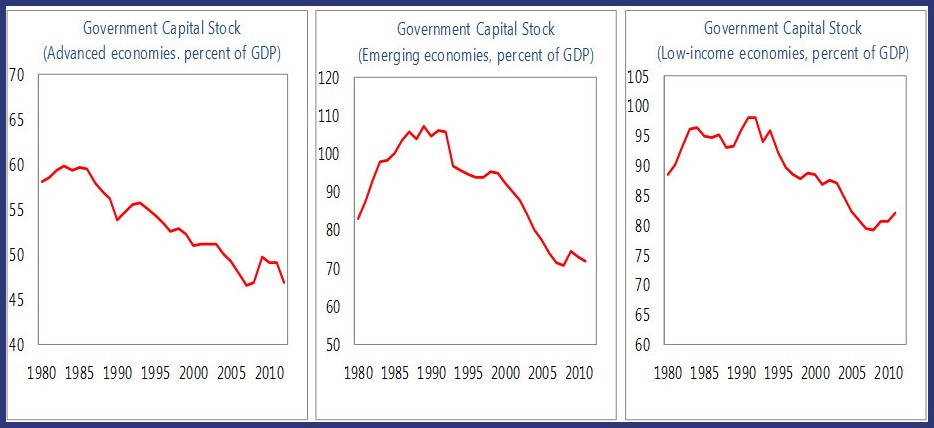(Version in Español, Français, Русский, 中文, and 日本語)
The global financial crisis brought to the fore the question of sustainability of public finances. But it merely exacerbated a situation that was bound to attract attention sooner or later—governments all over the world have been spending more and more in recent decades. Here at the IMF, we’ve been looking into the factors behind this increase in public spending, particularly social spending, and our latest Fiscal Monitor report discusses some of the options for spending reform.
Explaining the Growth of Government
How much governments spend mainly reflects a country’s individual preferences about the desired size of the government and services it delivers. Yet, over a number of years now, government spending as a share of overall economic output has been on a clear upward trend. Some of this may be due to fundamental economic factors (Chart 1).
Chart 1. Upward Trends in General Government Spending (percent of GDP)
The nineteenth-century German economist Adolf Wagner theorized that the demand for public goods and services increases as countries become richer (“Wagner’s Law”). William Baumol provided another explanation, namely that the cost of public provision of goods and services tends to increase faster than productivity; his example was orchestra musicians, whose salaries rise even if they arguably don’t play much better than decades earlier (“Baumol’s cost disease”). Our own analysis reported in the Fiscal Monitorprovides evidence supporting both hypotheses.
These findings imply that, in the absence of mitigating measures, pressure on governments to spend will continue, though possibly at a slower pace as income and productivity growth level off. In fact, our estimates suggest that, in the absence of reforms, government spending in emerging market economies could increase by between 3 and 6 percentage points of GDP through 2050.
And upward pressure on public spending is likely to come from at least two other sources: population aging, which will increase the cost of providing health care and pensions; and the normalization of monetary policy, which will increase debt payments when interest rates eventually start to rise.
Options for spending reform
The main task for governments is to ensure their finances remain sustainable now and into the future while still fostering growth and equity, and somehow do this in the face of the pressures to increase spending. To square that circle, governments will need to strike a delicate balance between tax policy and spending reform.
In advanced economies, where consolidation needs are largest and room to raise additional revenue through taxes is limited, spending cuts may be necessary as part of a wider reform strategy. In many emerging market and low-income economies, on the other hand, large shares of the population lack access to a full range of public services such as education and health care. In their case, there is scope to expand the provision of public goods and services by raising taxes. But some reprioritizing of expenditure is also likely to be needed.
Country circumstances and preferences clearly matter and the devil—as always—is in the details, but some common elements emerge from the experience that countries have had with expenditure reform:
- Countries should avoid across-the-board spending cuts . Although they may be expedient, such cuts are neither efficient nor welfare-enhancing, and have deleterious effects on the economy’s long-term ability to grow.
- Restoring sustainability will require containing social spending and the public wage bill, which together make up the bulk of government spending. Reining in the growth of social spending requires tackling public pensions and welfare benefits. In the case of pension reform, gradually raising the retirement age, while protecting the vulnerable and expanding access when needed, seems to be the most attractive option. In both advanced and developing countries, improving the targeting of welfare benefits can generate fiscal savings without compromising equity. Reducing the wage bill in a durable way would require replacing the wage and hiring freezes implemented in several countries since 2009 with deeper structural measures.
- Governments can achieve cost-savings by improving efficiency. The scope for efficiency gains appears to be large in the provision of education and health care and in public investment—the latter is particularly relevant for low-income countries.
- The trend decline in public capital stocks in advanced and emerging market economies will need to be gradually arrested. Slowing this decline (Chart 2) will require more productive public investment or increased private sector participation.
- Supportive fiscal institutions can boost the effectiveness of expenditure reforms. Empirical evidence suggests that effective decentralization frameworks and expenditure rules, for example, can help promote spending control.
- Last but not least, expenditure reforms are more likely to be successful and long-lasting if supported by wide political consensus. A broad communications strategy is especially important as political uncertainty and social pressures can easily derail reforms.
Chart 2. Downward Trends in Government Capital Stock






